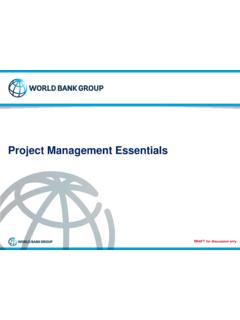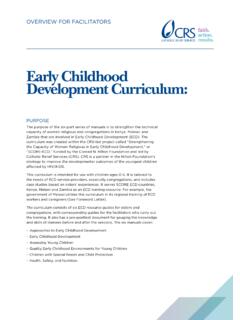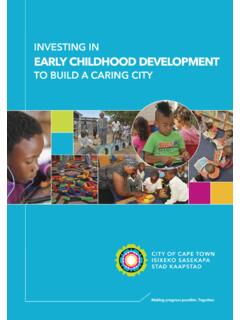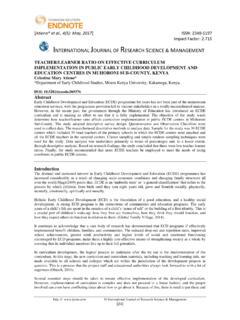Transcription of A global history of early childhood education and care
1 SBK global HX ECEC 2007/ED/EFA/MRT/PI/19 Background paper prepared for the education for All global Monitoring Report 2007 Strong foundations: early childhood care and education A global history of early childhood education and care Sheila B. Kamerman 2006 This paper was commissioned by the education for All global Monitoring Report as background information to assist in drafting the 2007 report. It has not been edited by the team. The views and opinions expressed in this paper are those of the author(s) and should not be attributed to the EFA global Monitoring Report or to UNESCO. The papers can be cited with the following reference: Paper commissioned for the EFA global Monitoring Report 2007, Strong foundations: early childhood care and education . For further information, please contact SBK global HX ECEC Sheila B.
2 Kamerman * * Professor, Columbia University School of Social Work and Director, Institute for Child and Family Policy TABLE OF CONTENTS 1. Introduction 2. A global Overview 3. Europe and North America 4. Developing Countries Africa Asia Latin America 5. Summary and Conclusions 6. Appendix Tables SBK global HX ECEC 1 INTRODUCTION early childhood education and care are services for children under compulsory school age involving elements of both physical care and Apart from their critical contribution to cognitive stimulation, socialization, child development , and early education , they are an essential service for employed parents. Before and after school programs may also be provided for primary-school--aged children.
3 (The data concerning these programs are far less available, however.) ECEC programs include a wide range of part-day, full-school-day, and full-work-day programs under education , health, and social welfare auspices, funded and delivered in a variety of ways in both the public and private ECEC programs may be publicly funded and delivered (the predominant pattern in the Nordic countries, for example) publicly funded and privately delivered (as in the Netherlands and Germany, for example), or include a combination of publicly-funded and delivered, publicly-funded and privately delivered, and privately funded and delivered programs as in many of the less developed countries such as Brazil as well as most of Africa, for example. They may be free, in particular those programs delivered under education auspices, or they may charge income-related fees; but in almost all of Europe they are heavily subsidized by government.
4 The services are voluntary and take-up is high where the programs are free or at very modest and the quality adequate. Some European countries have guaranteed a place for all children by the time they reach a certain age ( age 1 in Sweden, Denmark, and Finland, and age 3 in Germany) (Kamerman, 2000, 2001; OECD, 2001). They may be permitted to enter albeit without a right to participate, when they are 3 or 4, as in much of Africa and Asia. And they end when compulsory primary school begins at age 5 6, or 7. But access is very limited in most of the countries in Africa, Asia, and Latin America. The major cross-national differences have to do with such variables as: the locus of policy-making authority (national, state or province, or local); administrative auspice ( education , 1 These services include center day care, family day care, pre-Kindergarten, Kindergarten, nursery schools, play groups, drop-in centers, etc.)
5 The several EFA global Monitoring Reports refer to early childhood care and education (ECCE) as programs that last at least two hours a day and 100 days a year. The International Standard Classification of education (I ISCED) level 0 constitutes pre-primary school for children aged 3 to primary school entry. The Dakar Framework (2000) makes it explicit that ECEC is not limited to formal schooling but includes care as well; but it does not clarify the relationship between care and education ; and children in day care centers may not be counted as enrolled in early childhood education in some countries. The developed countries increasingly view the two functions as *2 The acronyms for early childhood education and care vary. The EFA, GMR team uses ECCE for early childhood care and education . The OECD uses ECEC for early childhood education and care.
6 Unicef uses ECCD for early childhood care and development . The World Bank uses ECD for early child development . For the purposes of this paper, these labels are interchangeable. SBK global HX ECEC 2 health, social welfare, or a combination); age group served (infants and toddlers; preschoolers); access and percentage of age group covered; universal or means tested; other eligibility criteria (poor; with a single parent; with employed parents; children with special needs); funding strategies (government, national and international philanthropic organizations (NGOs), employer, parents' fees, combination); delivery strategies (supply or demand); locus of care (pre-primary-school; center; caregiver's home; in-own-home), primary caregiver (professional; paraprofessional; relative; parent); and program philosophy, as relevant (Kamerman, 2001).
7 In this paper, my focus is on the history of ECEC around the world. I will begin with a global overview of developments followed by a description of the major regional variations (Africa, Asia, Latin America, and Europe/AngloAmerica) and include a few country illustrations in each There are significant regional and country variations but strong similarities cross-nationally as well, especially with regard to a dominant ECEC paradigm. My main focus will be on the developments between the 1960s (when social protection policies exploded in Europe and the Anglo-American countries and the African countries became independent) and the 1990s, with some mention of earlier developments as relevant. My story ends with the remarkable developments culminating in the explosion of attention to ECEC in the 1990s: the Jomtien Declaration of 1990 and the Dakar framework of 1990 and the joint sponsorship by UNESCO, UNICEF, UNDP, and the World Bank of the World Conference on education for All, the launching of UNESCO s global Monitoring Reports, the World Summit for Children, the Convention on the Rights of the Child (CRC), and the launching of the OECD (Organization for Economic Cooperation and development ) Thematic Review of early childhood education and Care.
8 This cluster of developments launched a new era in the history of ECEC and requires a separate telling, in another time and place. What was the status of ECEC before this? How did these ECEC programs begin and how did they develop over time? What are the major differences and similarities? What was the relationship between care and education ? What were the public responses and the patterns of child enrollment? 3 The case illustrations include both brief and more extensive histories. They draw on secondary sources and my own research and research of staff of the Columbia University Clearinghouse for International Developments in Child and Family Policies. The European and North American cases are drawn from EU and OECD reports and my own research. The more extensive cases from the developing countries are drawn from the Clearinghouse (China and India in the Asian region and Columbia in the Latin American regions, and from the OECD ECEC thematic review (Mexico) and Unesco reports (Kenya, Maurituus and Senegal.))
9 The countries were selected because of significant population size, contrasting cultures, and the availability of historical material. SBK global HX ECEC 3 A HISTORICAL OVERVIEW In attempting to paint a picture of global developments in early childhood education and care policies and programs, we are confronted by the paucity of national data, let alone comparative, cross-national data. Reviewing the histories of ECEC developments in several countries reminds us that in much of Europe and North America, and even in several of the developing countries such as China and India, kindergartens and nurseries were first established in the 19th century, often drawing on the same models: Froebel, Pestalozzi, Montessori, and the activities of missionaries. early on, a distinction was made between kindergartens for educational purposes and day nurseries to provide care.
10 But subsequent developments were slow, with some expansion occurring during World War II and some following that. Except for the eastern European socialist countries, with extensive developments occurring right after the War II, and France, with the integration of preschool into the education system in 1886 and the expansion of the ecole maternelle in the 1950s, the most significant developments date from the 1960s: the end of colonialism, the establishment of independent states in Africa, the dramatic increase in female labor force participation rates, the extensive developments in child and family policies in Europe and the , the debate between care vs development as the critical issue in the ECEC field. To the extent that some comparative data exist, we are dependent on UNESCO for the findings of three world surveys, one in 1961, a second in 1974 (but published in 1976), and a third in 1988 (published in 1991); (UNESCO, 1961; Mialaret, 1976; Fisher, 1991).






